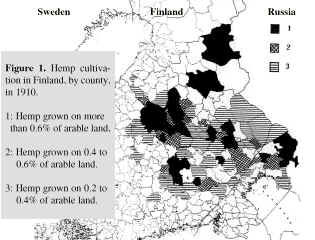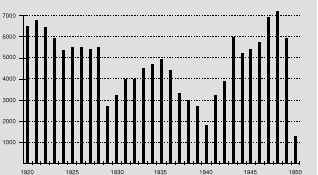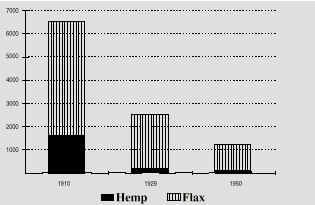
34
History of hemp in Finland
Erkki Laitinen
Voionmaankatu 24 B, FIN-40100 Jyväskylä, Finland
Arrival in Finland

Sweden Finland Russia
Figure 1. Hemp cultivation in Finland, by county, in 1910.
1: Hemp grown on more than 0.6% of arable land,
2: Hemp grown on 0.4 to 0.6% of arable land.
3: Hemp grown on 0.2 to 0.4% of arable land.
Pollen analysis
Hemp pollen is both easy and difficult to study.
It is carried by wind and found in the bottom of lakes and ponds located near
cultivation. Problems arise when trying to establish the difference between the
pollen of hemp and that of hops, its botanical relative. In most studies, hemp and
hops are not separated from each other. Instead, they have been reported as
hops/hemp or Cannabaceae. Hemp pollen is always a sign of its cultivation, since
hemp has never grown wild in Finland. Pollen from hops, however, is always from a
wild plant, for only the female plants were cultivated and not the pollinating males.
Wild hops can also be a proof of human influence on nature, for the plant spread
with people. However, one cannot build a comprehensive picture of hemp's early
history in Finland solely on the grounds of pollen analysis.
Pollen from Cannabaceae, dating as far back as the year 4000 BC and
from several periods before and after the year 2000 BC, was found in samples from
Säkinlampi (a pond in the county of Hankasalmi in Central Finland) during 1994.
However, according to Dr. Virma Vuorela, these pollen samples were from wild hops.
The next time period showing pollen from Cannabaceae was from 500-600 AD. This is
also the time when pollen from cereal plants increased significantly. This time
period can be regarded as the beginning of stable agriculture in Hankasalmi and Central
Finland. It is possible that hemp was then cultivated in the area, although it is
more likely that the plant in question was actually wild hops.
Pollen found in the bottom sediments of Armijärvi of Hattula in the
region of Häme (in the Finnish southwest) was dated in a pollen analysis to be from the
year 570 AD. The study, however, was unable to specify whether or not the plant in
question was hemp or hops. Again, this dates back to a time of major increase in
pollen from cereal crops. If the plant in question is hemp, its cultivation started
with the beginning of established agricultural settlements.
According to pollen studies, hemp became common in the region of
Southern Savo (west of Southern Karelia) during the 15th and 16th centuries, and its
cultivation was most widespread during the 18th century and into the beginning of the 19th
century. When estimating the culture of cultivation and the long history of hemp,
the latter observation is especially remarkable. It tells when hemp became "the
plant of the whole population" and when its economical importance was at its
greatest.
Current thought
The main objective of pollen and macro-fossil
studies is not to know the exact date of the earliest observations on cultivation but the
main lines of development. So far, the results can be summarized as follows.
Cultivating hemp in Finland is older than what has been formerly believed. It is
younger than the cultivation of cereals but, at least in Finland, its breakthrough and
popularity began at about the same time as a period known as "the second
expansion" of pioneer settlements during the 15th and 16th centuries. This is
when stable agricultural settlements became significantly more established. In
Central Finland, the beginning of agriculture, a period known as the "first
expansion" roughly dates back to the years 500-700 AD. It is possible that the
"base population" practicing inland agriculture was already cultivating hemp
but, at least so far, this has not been convincingly demonstrated. In the old
southwestern agricultural regions of Finland, hemp has been cultivated for at least 1,000
years, and maybe even over 1,500 years.
Based on macro-fossil studies one might estimate that hemp cultivation
may have spread into southwestern Finland through Central Europe, the Baltic or
Scandinavian regions and not necessarily from Russia. Hemp most certainly spread
into Eastern Finland from Russia, as has been assumed to this day. According to many
researchers, the cultivation of hemp in Finland is older than that of flax.
Paleoecological research is reshaping the entire history of settlements
and agriculture in Finland. A new assessment considering the whole country in this
matter has yet to be done, even though a lot of local pilot studies have already begun.
When representative sites of the total area are eventually surveyed, the picture of
early hemp history in Finland may also become clearer.
Regional expansion
According to pollen studies and written sources the
cultivation of hemp increased noticeably during the 18th century. Its greatest
expansion in Finland takes place in the 18th century and beginning of the 19th century.
By this time, hemp was already cultivated throughout most of the country. Its
cultivation was more common than flax. Hemp was cultivated to a particularly large
extent in Eastern Finland, where flax was almost unknown. Hemp from Eastern Finland
was taken, for example, to Pohjanmaa (a region located in the northwestern part of
Finland). In the region of Häme (central and southwestern Finland), hemp
cultivation flourished in the same locations as flax cultivation. In other words,
hemp and flax were not excluding each other as alternatives. In the region of Häme,
one could even talk about particular fiber plant areas. People from Häme sold flax
and hemp into Southwestern and Western Finland.
The most prominent core area for hemp cultivation was in Eastern
Finland, in the Karelia and Savo regions. The skill for its cultivation was also
more highly developed there, when compared to Southern or Western Finland. People
from Eastern Finland knew to treat the male and female plants differently for optimal
fiber production. This knowledge was unknown to Western Finns. Male hemp
plants are shorter and mature earlier than female plants. When the male plants were
pulled out of the ground, two weeks before the females and treated separately, a finer
fiber was obtained from the males. In this way, Eastern Finns substituted the need
for thinner fibers and finer fabrics from hemp instead of using flax. In Western
Finland all hemp plants were pulled up at the same time, discarding the dry and hardened
males.
Exact statistics on the regional cultivation of hemp , by county, only
exists from the first Finnish agricultural census in 1910 (Figure 1). Only those
counties having at least five hectares of hemp cultivated per 1,000 Ha of arable land are
included. It is clear that in the beginning of the 20th century hemp was mostly
cultivated in Eastern and Central Finland. However, this was a period when hemp
cultivation was already in a steep general decline. In the long history of hemp
cultivation, Southern and Western Finland were once planted much more densely.
Finnish use
Hemp was a versatile plant in Finland. Coarse yarn
was spun from it after the fibers had been separated from the stalks. Durable
fabrics were woven from this yarn. Eastern Finns, especially, wore primarily hemp
clothes well into the 19th century. Hemp was separated into different categories,
according to fineness, and was made into linen, towels and table cloths, work cloths, etc.
Hemp twine was knit into fishing nets and sacks, and it was also good material for
making sails.
Until the post-Second World War era, hemp was the most abundant raw
material in the world to make rope. Being a plant with long and strong fibers, it
was ideal for this purpose. Water resistant hemp rope - especially if it was tarred
- was well suited for damp and wet conditions. Particularly large amounts of rope
were needed during the period of sailing ships. Until the late 19th century, ropes
were made by hand. Although the Englishman, Huddert, had already patented a rope
twining machine in 1793, it was not used industrially in Europe until 1862. Little
by little, mechanical twining replaced twining by hand. The latter method remained
as a means of providing rope for the Finnish home needs or for small scale local sales
well into the 20th century. In some areas Finnish rope was still made by hand after
the Second World War.
Rag paper is an old Chinese invention. In Finland its production
was started in the middle of the 17th century from rags that were gathered from hemp and
flax clothing. Torn rags were beaten in water into a mass, out of which thin sheets
of fiber were rolled out. These were dried and pressed into paper. Paper
making, which had started as handwork, slowly developed into an industry.
The first paper factory in Finland was established in Tervakoski in
1818. It concentrated on making rag paper even after the use of wood as raw material
became common in other Finnish paper factories during the 1860's. Even during the
period between the two World Wars, only rag paper was made in Tervakoski and the addition
of wood fibers to rags was implemented only after the Second World War.
Better, thinner and stronger paper is obtained from rags than from
wood. Until the time just after the Second World War, and to some extent until
today, rag paper has been used for the production of the most demanding paper qualities
required for fine printing (e.g., currency, bibles, stamp, and bonds), as well as
exceptionally thin cigarette paper. Most Finnish currency was printed on rag paper
starting from the latter part of the 19th century. The paper of modern money is
still made of hemp and flax fibers.
Since hemp and flax fibers were so well suited for paper making, why
were they not made directly into paper, but only after they had been used as fabric?
Probably because it would have become too expensive, since processing hemp and flax
into fiber was so labor intensive. Rags and discarded clothes were cheaper fiber
sources and more easily processed into paper mass than fibers taken directly from plants.
Flax fibers were not bought directly from farmers by Tervakoski factories before or
during the Second World War and sources do not reveal to what extent rags were used or
what part of those rags were hemp or flax. Probably during the 19th century, and in
the beginning of the 20th century, hemp was more widely used. Most of the hemp rags
were brought into Finland from Russia, which at that time was the largest producer of hemp
in the world. As the 20th century progressed, flax became increasingly more common.
The oil pressed out of hemp seeds had been used in Finland, for
example, as a lamp oil, a raw material for soap and in the production of varnish.
Decline of cultivation
Practically speaking, hemp cultivation ended in
Finland during the 1950's. By the beginning of 1960's hemp was not grown any more,
aside from some private farms for domestic needs. However, the decline of hemp had
started a lot earlier: in Southern Finland at the beginning of the 19th century, and on a
national scale during the latter part of the 19th century. First flax passed hemp as
the most important fiber plant for home use, and then for the textile industry. The
use of flax was eventually replaced by cheaper cotton imports. Also the
commercialization of agriculture added to the decline of hemp cultivation. When more
wood began to be sold to bring in money, the labor intensive and time consuming chores
associated with the cultivation of hemp and flax lost their appeal. Modern fabrics
and clothes could be more easily bought rather than made.
Exact yearly records for the cultivation of fiber plants can not be
obtained before the year 1920. The development of the total area of cultivated fiber
plants (hemp and flax) since the year 1920 is illustrated in the Figure 2.

Figure 2. Area of hemp and flax grown from 1920-1950 in hectares.
During the 1920's fiber plant cultivation experienced a slight decline, which became steeper towards the end of the decade. During the years of shortage in the beginning of the 1930's the cultivation of flax and hemp increased, but during the years of a strong economy at the end of the decade, cultivation turned towards a steep decline again. During the shortage and regulations of the World War II years, people in Finland had to turn back to the cultivation of fiber plants. But as soon as the restrictions were abolished, importation resumed and with more available money, production of hemp again declined sharply. Figure 3 shows the ratio between the cultivation of hemp and flax, and illustrates how hemp cultivation clearly declined before the cultivation of flax.

Figure 3. Area of fibre plants in hectares.
New era?
To be realistic, one must recognize that a large
scale reintroduction of fiber plant cultivation - especially hemp - in Finland would not
be an easy task. The history of Finnish agriculture offers plenty of examples where
areas of production have dwindled and lost their importance against cheaper imports.
Besides flax and hemp, other examples include the raising of goats (very common at
one time), the raising of sheep (almost disappeared), the growing of buck wheat and the
use of different kinds of roots in feeding cattle.
It is difficult to rekindle the fire under a production area that has
already declined, and which is also labor intensive. Examples of this also exist in
industry and in the crafts. Now, even the cultivation of rye, which should be a
sacred matter for Finnish culture, seems threatened in the new EU-Finland. Even
without obstacles (e.g., legal regulations), the hindsight of history implies that the
task of reviving hemp cultivation will require new economic and ecologic ideals, which
must then break through into Finnish agriculture and industry. However, an interest
towards blowing new life into hemp cultivation has already awakened in Finland.
Acknowledgements
Translation from the original Finnish article,
Hampun Historia Suomessa, was admirably performed by Anita Hemmilä. Additional
thanks are due to J. C. Callaway for proof-reading the manuscript.
References